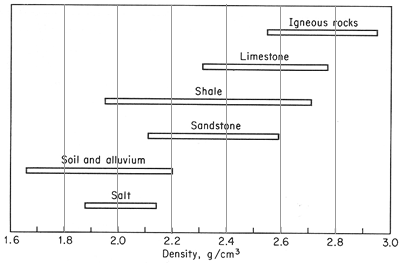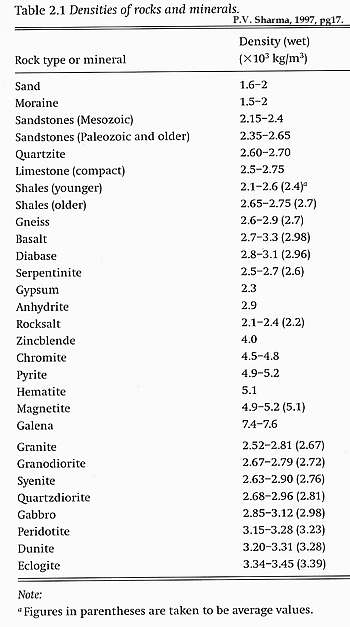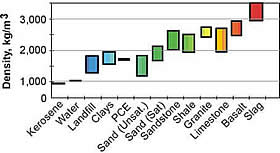| |
Introduction
Unlike other physical properties, the densities of the commonest rock forming minerals are remarkably close together. The actual densities of pure, dry, geologic materials vary from 880 kg/m3 for ice (and almost 0 kg/m3 for air) to over 8000 kg/m3 for some rare minerals. Rocks are generally between 1600 kg/m3 (sediments) and 3500 kg/m3 (gabbro). Tables of geologic material densities are given in most text books, but the simplicity of a table hides the wide range of values most real materials can exhibit in the field. Nevertheless, a table is useful, and Table 2.1, from PV Sharma, 1997 (see the references page) is shown on the right. In practice, bulk densities (the density of an entire volume of material, including the void space) are often controlled more by the porosity, the degree of cementation, and the mixing of materials, than by the mineral composition. The following figure (Grant and West, 1965) emphasizes the challenge of interpreting geologic material from density measurements due to the wide ranges of overlapping values exhibited by materials.

Bars indicate spans of 80 percent of small-specimen bulk sample densities of various kinds of rocks.
|
 |
 To the right is a similar figure (from the Federal Highway Administration online geophysical imaging resource site) with some additional materials. The figures are in general agreement, but they are not the same. It might be more sensible to treat the upper and lower bounds of such bar graphs as very fuzzy. To the right is a similar figure (from the Federal Highway Administration online geophysical imaging resource site) with some additional materials. The figures are in general agreement, but they are not the same. It might be more sensible to treat the upper and lower bounds of such bar graphs as very fuzzy.
It is important to recall the difference between mass, density and weight. Density is the physical property - it is mass (kilograms) per unit volume. Weight is the force experienced by that mass in the presence of a gravitational field. Your weight on the Moon is 1/6th of your weight on Earth, but your mass (and density) is the same wherever you are.
Porosity
 The effect of density on porosity follows a mixing law, which is described subsequently. Therefore, measuring bulk density of a sample can provide an estimate of porosity if the constituants of the bulk sample are known. The porosity, The effect of density on porosity follows a mixing law, which is described subsequently. Therefore, measuring bulk density of a sample can provide an estimate of porosity if the constituants of the bulk sample are known. The porosity,  , is the fractional pore volume of a rock (for example the black zone in the cross section of a sedimentary rock to the right). The total mass of a volume of rock, VT, is made up of the mass of the pore fluid, of density df, plus the mass of the matrix minerals of density dma. The density measured is the bulk density db. The total mass then becomes: , is the fractional pore volume of a rock (for example the black zone in the cross section of a sedimentary rock to the right). The total mass of a volume of rock, VT, is made up of the mass of the pore fluid, of density df, plus the mass of the matrix minerals of density dma. The density measured is the bulk density db. The total mass then becomes:
Total mass = VT db =  VT df + (1- VT df + (1-  ) VT dma ) VT dma
So we have a formula giving the Mixing Law for density, which represents bulk density in terms of the porosity, pore fluid density and the matrix density:
db =  df + (1- df + (1- ) dma ) dma
By re-arranging the terms, the porosity can be represented in the following way:
 =(dma- db)/(dma- df) =(dma- db)/(dma- df)
When both the rock type of the matrix and the fluid type are known, the porosity can be estimated from measurements of density. This is commonly done in boreholes where density instruments can yield accurate estimates of bulk density db. This is also possible when there are core samples, although care must be exercised to find true densities without bias from damaged cores.
Remarks
- Most of the rocks comprising the crust of the earth have density between 2.6 and 2.7g/cc.
- Some basic igneous rocks, which not only have very low porosity, but contain more iron-rich mafic minerals than their upper crustal counterparts, have density ranging from 2.8 to 3.0 g/cc; some exotic rocks of deep seated origin have denisity as high as 3.4 (e.g. eclogite).
- Ore minerals, oxides and sulfides of various metals are relatively dense (see the table above).
- Clays generally have density between 1.6 to 2.6 g/cc. The clay content of a soil has a significant effect on its density.
- Salt is of particular interest in sedimentary rocks because it has a low density (2.2 g/cc), but has a fairly high bulk modulus giving it a relatively high seismic velocity (velocity of acoustic signals within the rock). Therefore, gravity surveys are an excellent ajunct to seismic work in the exploration for petroleum products.
- Other than when salt or ore minerals are present, the density contrasts between host and "target" materials encountered in gravity studies of the crust rarely exceed 0.250g/cc.
- The contrasts are higher for shallow materials. For this reason, in combination with the close proximity of measurement locations to targets, gravity methods are useful for mapping overburden thickness. Gravity is also often highly effective at identifying and mapping voids, such as sinkholes, caves in Karst formations, etc.
These notes were adapted and augmented from a similar page at the Berkeley Course in Applied Geophysics website. |
|

